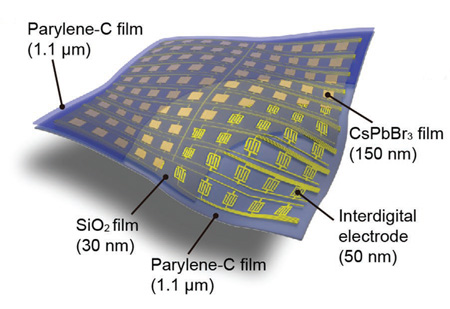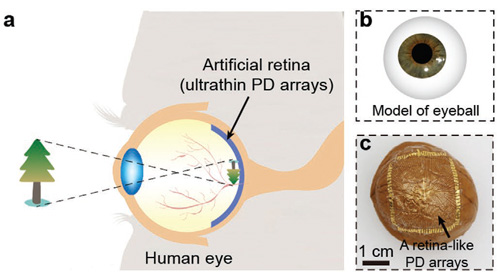| Mar 04, 2021 |
Retina-like vision sensing with perovskite photodetectors
(Nanowerk News) Rapidly advancing technology fields such as wearable devices, soft robotics, and healthcare monitoring, require ultrathin flexible optoelectronic devices. These devices need to meet requirements of light weight, ultra-flexibility, and conformal contact. Novel 2D materials are emerging as superior candidates for these applications.
|
|
In particular, perovskite materials with remarkable physical properties could be synthesized on various substrates with low-cost solution-processed methods at modest synthetic conditions, opening exciting directions for the fabrication of ultrathin flexible optoelectronic devices.
|
|
So far, though, the fabrication of ultrathin flexible perovskite-based photodetector arrays remains a significant challenge, due to perovskite materials not being compatible with photolithography techniques, and peeling-off methods involving polar liquids.
|
 |
| Schematic structure of the ultrathin photodetector arrays. (Reprinted with permission by Wiley-VCH Verlag)
|
|
Reporting in Advanced Materials ("Ultrathin and Conformable Lead Halide Perovskite
Photodetector Arrays for Potential Application in Retina-Like Vision Sensing"), researchers in China demonstrate an ultrathin (2.4 µm) and conformable CsPbBr3 perovskite-based PD array with ultralight weight (3.12 g m-2) and excellent flexibility.
|
|
The team points out that their ultrathin photodetector arrays could find potential applications in artificial vision sensing.
|
|
For the preparation of an ultrathin flexible substrate, the researchers employed an ultrathin parylene-C film (1.1 µm-thick) which they deposited on a p-Si wafer through a polymer organic vapor deposition system.
|
|
A crucial step in the device fabrication process is complete exfoliation of the ultrathin device from the p-Si support wafer without wrinkles and damage.
|
|
Artificial retinas, which mimic the biological functions of human eyes, rely on large-scale photodetector arrays to realize the recognition function of perceiving images.
|
 |
| Demonstration of the ultrathin photodetector arrays imaging capacity. a) A schematic illustration of the ultrathin device with excellent mechanical robustness could be used for artificial vision sensing. b) Model of the eyeball. c) Photograph of ultrathin PD arrays conformed to a walnut. (Reprinted with permission by Wiley-VCH Verlag)
|
|
As shown in the figure above, the team's ultrathin device with excellent mechanical robustness, can form conformal contact on irregular surfaces, demonstrates potential application in artificial vision sensing.
|


 By
Michael
Berger
– Michael is author of three books by the Royal Society of Chemistry:
Nano-Society: Pushing the Boundaries of Technology,
Nanotechnology: The Future is Tiny, and
Nanoengineering: The Skills and Tools Making Technology Invisible
Copyright ©
Nanowerk LLC
By
Michael
Berger
– Michael is author of three books by the Royal Society of Chemistry:
Nano-Society: Pushing the Boundaries of Technology,
Nanotechnology: The Future is Tiny, and
Nanoengineering: The Skills and Tools Making Technology Invisible
Copyright ©
Nanowerk LLC
